Working Springer spaniel puppies are intelligent and flexible dogs that can adapt well to family life, either as a pet or a working dog.
Springer spaniel puppies are delightful little balls of fluff and fun but, if you are thinking of getting one then you should realise that the little cuddly pup will grow up into a strong, active and clever adult, that needs lots of exercise and training.
The secrets to training a Springer spaniel puppy are consistency, patience and reward based training. If you develop your understanding of dogs and how they think then you will be a better dog trainer and owner and will be significantly better than the majority of dog owners.
Are Springer spaniel puppies hard to train?
The simple answer to this is that no they are not hard to train at all, however, if you don’t know anything about dogs or puppies then you may find the process to be tricky.
English springer spaniels are intelligent dogs that want to please their owners and have a strong desire to be with people.
This desire to please is something that the good spaniel owner will take advantage of to make training as easy as possible.
Probably the most difficult aspect of Springer training is the trainer or owner who often need to develop their understanding of Springers and dogs in general.
Before you train a Springer spaniel puppy
If you are new to Springer spaniels then you’ve chosen a brilliant breed of dog and hopefully will have done some prior research into the breed and dogs in general.
If you haven’t lived with a dog before or are new to Springers then it’s always a good idea to try and develop your understanding of how dogs behave and think.
Many new dog owners make the mistake of jumping in and not training themselves – and part of the joy of spaniel training is in developing your knowledge and understanding.
There are many good books available to further your learning of Springers and dogs in general, and I’ve used many of them.
Recommended reading for Springer owners
[amazon table=”7810″]
Initial training advice
Always remember that your Springer puppy will want to be with you and wants to please you. To him you are the most important thing in the world.
Remember that he is a baby and doesn’t understand fully what you want.
The days of using force on dogs when training are long gone and you should rarely, if ever, need to lay hands on your Springer spaniel pup.
If, during your training session, things don’t go to plan, then it is best to stop, think about it and try something else – either you or the dog are having a bad day.
Better to take a deep breath and do something that the puppy knows and finish on a positive note.
When do you start training a Springer spaniel puppy?
You will begin training with your Springer puppy as soon as he has settled into your home.
Although I use the word ‘training’ what we are really doing is introducing some little good habits that will get the puppy off on the right track and which will help him when he is older and begins be his ‘proper’ training.
It is important to not rush when training, your spaniel needs to develop his personality which you help him with as he grows older.
Proper formal training begins when he is around six months of age – or older depending on his personality.
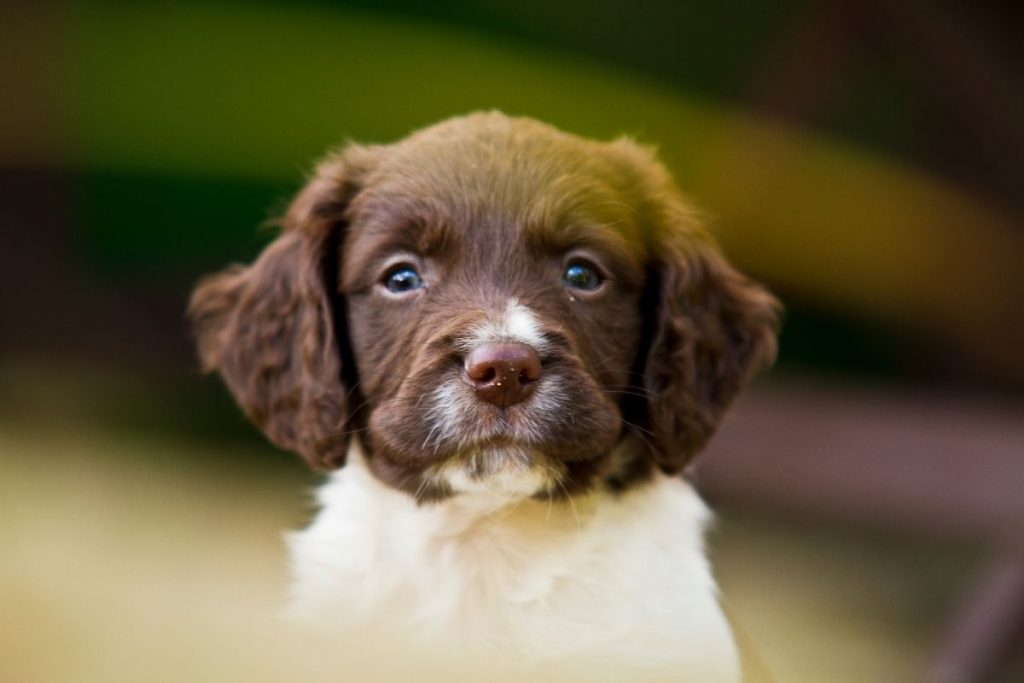
Teach your Springer spaniel puppy his name
Your puppy needs a name and I agree this can be to decide, but it’s something that you have to do. Try to pick a short, snappy name for him.
Introduce him to his name by stroking him, telling him that he is a good dog and making reassuring noises.
Talk to him and use his name when you stroke and fuss him.
When he is trotting around your house, bend down and encourage him up to you, calling his name.
When he comes bouncing up to you, make a big fuss of him and tell him what a good dog he is.
You should play with the puppy as often as possible, help him to get to know you and the family, be gentle with him, he is just a baby and encourage him whenever you can.
Calling him to you helps to form and embed the beginnings of the recall command which he will need to learn when he is older.
This simple little exercise helps you to pave the way for his future, adult training.
Housetraining a Springer spaniel puppy
Forget the experts
To begin with this important area it is vital that you forget and ignore what all the experts and old wives have told you about housetraining dogs.
There is no room for crates or ‘rubbing dog’s noses’ in it .
Dealing with crates – anyone who suggests locking a puppy inside a crate to ‘housetrain it’ should be locked in one themselves.
There is no need for this cruel behaviour which aims to use force/restrictions to stop the dog fouling.
It works on the ‘thinking’ that the puppy won’t go to the toilet where he sleeps.
What it doesn’t do is consider the puppy and his needs.
As for the old wives tale of rubbing a puppy’s nose in it – well anyone who tries that is devoid of intelligence and should not have dogs.
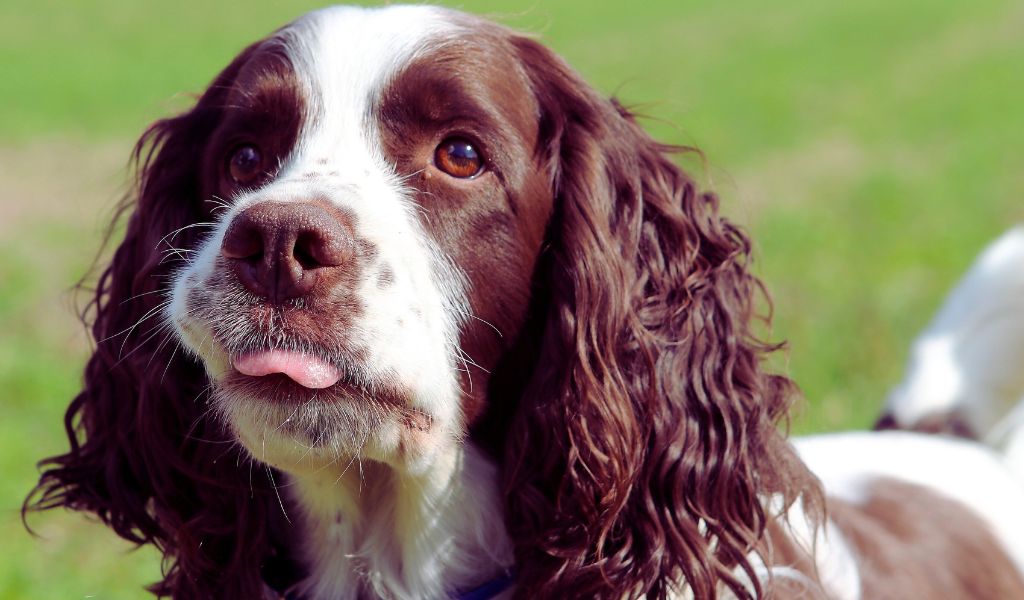
The correct way to housetrain a Springer puppy or any dog
This is straightforwards but needs consistency and effort on the part of the human beings – ie you and your family.
You will need to start thinking dog and understand the little signals that your puppy sends out when he needs to go to the toilet:
When he wakes up – just like you he’ll need to go
After a meal – take him outside
When he starts sniffing around – take him out
When he becomes restless – take him out
Be prepared for accidents while he learns that he should go outside and while you learn how to spot the signs.
Never, ever punish him for making a mistake and a mess in the home.
If he does have an accident then the reality is that it is your fault – he will have told you – you just didn’t recognise the signs.
Be consistent and take your time. When you do take him out tell him to ‘be quick’ or whatever you decide and when he does ‘go’ make a big fuss of him.
He will get the idea – just be patient and consistent.
Crates should be used for sleeping and security – not for puppy toilet prisons.
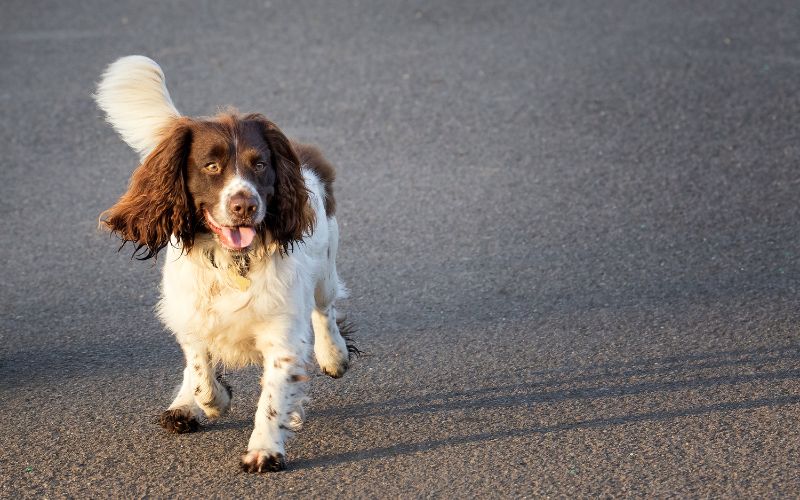
Basic training areas for a Springer spaniel puppy
As a young dog there are a few basics that you should be focusing on before your Springer spaniel puppy begins more formal training when he is older.
They are:
There are some that suggest that the puppy should understand more complex commands but this is not necessary at this early stage.
The little steps are enough for a young Springer puppy to become familiar with – more complex commands can be left ( and should be ) for when he is older.
For a full list of the things that you’ll eventually teach your Springer take a look at my article here.
[amazon box=”B00N4WX0EY”]
Training a Springer spaniel puppy to walk on the lead
Springer spaniels love to hunt freely and being on the lead is not something that they enjoy very much, you’ll find that most spaniels will pull on their leads in an attempt to get in front.
However, that said, it is really important that your Springer puppy becomes familiar with the lead from an early age both to keep him safe and, in some cases, it may be the law wherever you are.
I’d recommend that you use a slip lead for your puppy, they are easier to use, safer and quick to put on and remove.
Try to avoid using a collar if you are able and allowed to.
When you first put the lead on the puppy, he will probably jump around, pull and act like the proverbial ‘fish on a line’.
Don’t get cross or frustrated, you’ll just make things worse, instead, gently encourage the puppy towards you, calling his name and encouraging him along.
You can do this in the safety of your home, and this is probably the best place to start.
Only do it for a few minutes and, when you take the lead off, make a great fuss of the puppy.
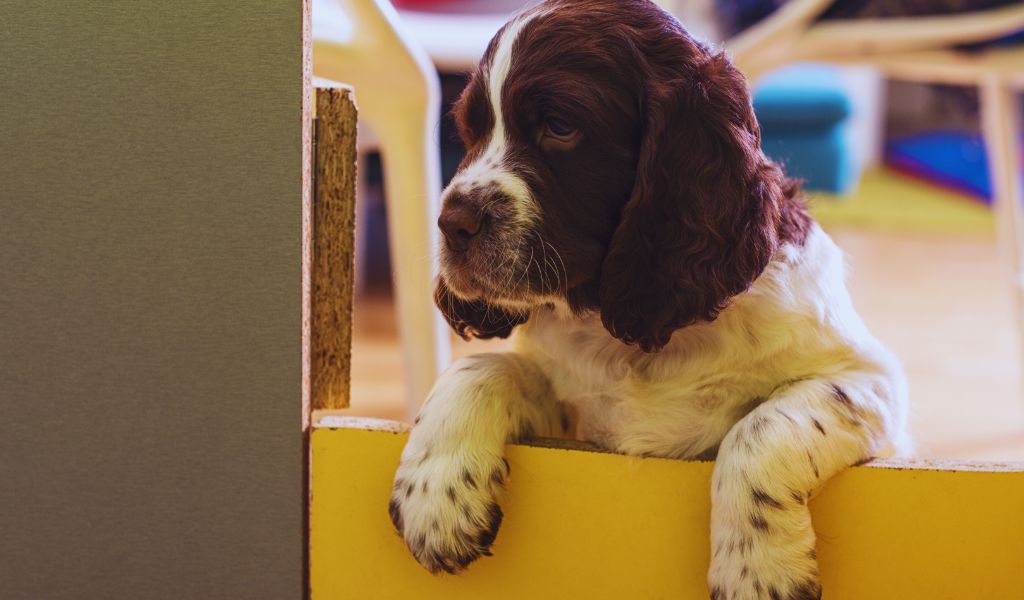
Use the lead regularly and walk him around for short periods of time and he’ll get the idea.
It doesn’t take long for a puppy to adapt to the lead.
If he begins to pull, don’t yank him back like some people say, you will only frighten him and may hurt him.
All you need to do is slow down and stop, give him time to calm down and settle and then tell him he is a good dog and carry on.
Encourage your puppy to walk on your left hand side.
Don’t worry about or try to make him walk to heel, this is not really something that you need to think about at this stage.
Training your Springer spaniel puppy to come when you call his name
You will have been working with your puppy in the house or garden, teaching him his name and calling him to you.
The next stage is to do this outside. If things have gone well at home then you should have little difficulty in getting him to come when you call him when you are out and he is running free.
One word however. When you first try this take him somewhere where there are no distractions, such as other dogs, wildlife, farm animals – go somewhere nice and quiet and safe, where he cannot escape.
It is also a good idea to have a few of his favourite treats in your pocket when you this.
Let him run free for a short time and call him to you. If he hesitates, walk backwards away from him, calling his name.
When he runs up to you, give him a treat, tell him he is a good dog and let him run free again.
Call him back a second time, reward him and put his lead back on. Then walk for a while before going home.
Keep it simple and be consistent. If you reward him with a treat and then let him have another run his thinking will be along the lines of ‘great, I get a treat when I go back and then he lets me have another run’..
Reward based training works best with spaniels. Try to keep that in mind.
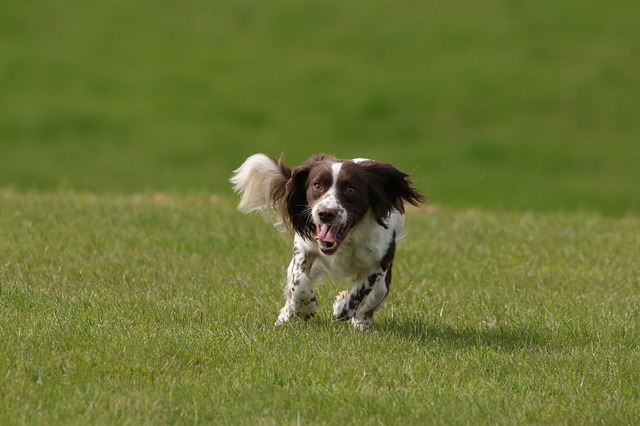
Training a Springer spaniel puppy to sit
As soon as your Springer puppy has settled in at your home you should teach him the ‘sit’ command.
This is the basic building block of all spaniel training and is the very first step that you will take.
It is very easy, involves no contact, no pressing down of his back or anything similar.
All you do is wait until mealtime. Put his food in his dish and hold the dish in your left hand.
Hold your right hand out, palm facing outwards ( like a stop signal ) and tell your puppy to ‘hup’ or ‘sit’.
He won’t have a clue what you mean and will jump around and get frustrated at not getting his food.
But, eventually he will sit down to contemplate the situation and, as soon as his bottom touches the floor, repeat the ‘hup or sit’ and put his food down in front of him.
From now on, at every mealtime, do this.
He will soon understand.
As he gets better you can do this occasionally outside of mealtimes – just give him a nice treat when you do it.
Training a Springer spaniel puppy to retrieve
Working Springer spaniel puppies love to pick things up and carry them around, things such as slippers, socks, balls and anything else that they can hold.
When we look to train a puppy to retrieve we are simply working with this love of carrying things around to suit our needs and we do this by making things as easy and fun as possible for the pup.
I always use some rolled up thick socks for this as they are soft, smell and are easy for a puppy to pick up and they don’t hurt his mouth.
The best place to start this is in the hallway of the house or somewhere similar such as an alleyway where the puppy finds it hard to run off.
Get your puppy’s attention, wave the socks in front of his face to get him interested and, when he starts trying to grab it, gently throw the socks and let him run after them.
If all goes to plan then he will pick the socks up, as soon as he does, call his name and encourage him to you.
If he returns, then great, take the socks off him gently and play again.
There is a good chance that he will run off with his ‘sock treasure’ and, if he does, don’t chase him, just keep an eye on him and pretend to ignore him.
Eventually he will come to see what you are doing when you can take the socks from him.
You can do this little exercise a couple of times daily and you can begin to tell him to ‘fetch’ when you throw the socks.
Keep things short and fun and enjoy training your puppy.
Help your Springer puppy to develop his confidence
Throughout the course of his life your Springer spaniel will encounter many different things. As a puppy it is important that you introduce him to as many different environments as possible when he is young.
Take him for walks in different places, at different times of the day in different weather.
Introduce him carefully to other people, children and adults. Take the time for him to meet other dogs and animals including, if possible farm animals and livestock.
You should try to develop his learning so that he grows into a sociable, friendly and confident adult dog so take every opportunity to help him to understand the world around him.
[amazon box=”1847979459″]
Maintain a positive attitude when puppy training
Always stay positive when you are training Springer spaniels.
Never lose your temper if things are going wrong – there will be days when training is not going well.
When you have a day or days when things are not going as expected, take some time off.
Give yourself and your dog a break, just go for walks, relax and switch off for a while.
Things will return to normal – don’t panic and don’t rush.
The training of a Springer spaniel puppy is not difficult if you take the time to understand your dog and how he sees the world around him.
Always remember that he is a dog, things that are normal to you may be scary or strange to him, He does not see things in the way that we do and this goes for training too.
Always be positive, end on a high note with something that your puppy can do well before you go home.
If things aren’t going well then have a holiday from training.
First and foremost he is your dog and he wants to do well, just give him the chance when training and he will.

